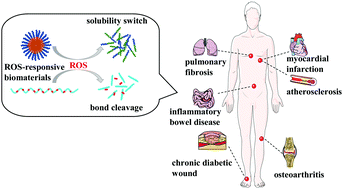Reactive oxygen species (ROS)-responsive biomaterials mediate tissue microenvironments and tissue regeneration
Abstract
Reactive oxygen species (ROS) have been considered the pivotal signaling molecules in many physiological processes, and are usually overproduced in various inflammatory tissues. Overproduction of ROS may disrupt cellular homeostasis, cause non-specific damage to critical components, and lead to a series of diseases. ROS are acknowledged as a type of emerging triggered event similar to acidic pH, overproduced enzymes, temperature and other specific stimuli found in pathological microenvironments. Recently, ROS-responsive biomaterials have been identified as a type of promising therapeutic substance to alleviate oxidative stress in tissue microenvironments, and for use as a vehicle triggered by inflammatory diseases to realize drug release under physiological oxidative microenvironments. In this review, we discuss mainly the mechanisms of ROS-responsive biomaterials with solubility switch and chemical degradation, and those ROS-responsive groups used in ROS-responsive biomaterials. The mechanism of ROS overproduction in pathophysiological conditions is introduced. The various applications of ROS-responsive biomaterials in tissue regeneration and disease therapy, such as cardiovascular diseases, osteoarthritis, chronic diabetic wounds, inflammatory bowel disease and other inflammatory diseases, are summarized.

- This article is part of the themed collection: Recent Review Articles


 Please wait while we load your content...
Please wait while we load your content...